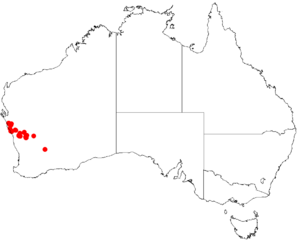Persoonia hexagona facts for kids
Quick facts for kids Persoonia hexagona |
|
|---|---|
| Scientific classification | |
| Genus: |
Persoonia
|
| Species: |
hexagona
|
 |
|
| Occurrence data from Australasian Virtual Herbarium | |
Persoonia hexagona is a type of flowering plant found only in the south-west of Western Australia. It belongs to the plant family called Proteaceae. This plant is a shrub that grows upright and spreads out. When it's young, its small branches, called branchlets, are very hairy. It has long, narrow leaves with sharp points. Its bright yellow flowers are also hairy. These flowers grow either by themselves or in groups of up to ten on a stem-like part called a rachis, which can be up to 40 millimeters (about 1.5 inches) long.
Contents
What Does Persoonia hexagona Look Like?
Persoonia hexagona is an upright, spreading shrub. It usually grows to be about 1 to 3.5 meters (3 to 11.5 feet) tall. Its bark is smooth. The young branchlets are hairy for the first two or three years.
Leaves and Flowers
The leaves grow one after another along the stem. They are mostly long and narrow, like a cylinder. Each leaf is about 50 to 130 millimeters (2 to 5 inches) long and 0.7 to 1.3 millimeters wide. They have six ridges running along their length.
The bright yellow flowers grow in a few ways. They can appear alone or in groups of up to ten on a stem called a rachis. This rachis can be up to 40 millimeters long. After the plant flowers, this stem often grows into a leafy shoot. Each flower sits on a small stalk called a pedicel, which is about 7.5 to 9 millimeters long. The flower parts, called tepals, are bright yellow and hairy on the outside. They are about 10.5 to 20 millimeters long. Inside the flowers are bright yellow anthers, which hold the pollen.
When It Flowers and What Fruit It Makes
Persoonia hexagona usually flowers from November to December. After flowering, it produces a smooth fruit called a drupe. A drupe is a fleshy fruit with a hard pit inside, like a peach or an olive.
How Persoonia hexagona Got Its Name
This plant was first officially described in 1994. A scientist named Peter Weston gave it its formal name, Persoonia hexagona. He wrote about it in a science journal called Telopea. He had collected samples of the plant near a place called Perenjori in 1980.
Where Persoonia hexagona Lives
This type of geebung plant usually grows in areas with Acacia trees. It can be found from near the Murchison River down to the area around Perenjori. These places are in specific natural regions of Western Australia. These regions include the Avon Wheatbelt, Geraldton Sandplains, and Yalgoo.
Is Persoonia hexagona Endangered?
The government of Western Australia, specifically the Department of Parks and Wildlife, has looked at this plant. They have classified it as "not threatened." This means that there are enough of these plants in the wild, and they are not currently at risk of disappearing.

